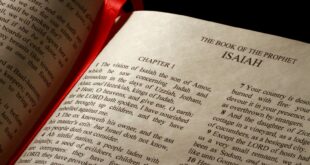How would you like to be called a “doubting Thomas”? After Jesus’ resurrection, Thomas made a statement that saddled him with that title throughout history. He neglected to meet with the disciples on that first Sunday when Jesus arose from the dead. He missed the most crucial church meeting of all time when the risen Christ met with the disciples for the first time. When the other disciples told him they had seen the Lord, he replied, “Except I shall see in his hands the print of the nails and put my finger into the print of the nails, and thrust my hand into his side, I will not believe.” (John 20:25).
The next Sunday, Thomas was with the disciples when Jesus appeared. Jesus was patient and loving toward Thomas. He said, “Reach hither thy finger, and behold my hands; and reach hither thy hand, and thrust it into my side: and be not faithless, but believing. Thomas was convinced and passionately said, “My Lord and my God.” (John 20:27-28).
In Thomas’ belief and emotions, seeing was believing. Please note that Jesus invited Thomas to check out the evidence of His resurrection. Jesus was alive and breathing in the flesh, visibly exposing the nail prints in his hands and inviting Thomas to feel his sword-pierced side. It was as if Jesus was saying, “Thomas, you have doubts. Check out the evidence. It’s right here on my body. Be assured so that you can serve me with confidence and boldness.” Jesus did not condemn him because he had doubts.
In what could be considered a mild rebuke, “Jesus saith unto him, Thomas, because thou hast seen me, thou hast believed: blessed are they that have not seen and yet have believed.” (John 20:29).
What kind of man was this “Doubting Thomas?” Jesus called him to be one of the original 12 apostles in Matthew, Mark, and Luke. When Jesus said he was going to return to Judea regardless of the danger warnings, Thomas, boldly said, “Let us also go, that we may die with him.” (John 11:16). When Jesus talked about going away to His Father’s house, Thomas was a questioner and asked, “Lord, we know not whither thou goest; and how can we know the way?” Jesus answered, “I am the way.” (John 14:5-6). Thomas was also with Peter at the fish fry hosted by Jesus in John 21. Later, he is with the apostles in the upper room after Jesus’ ascension. (Acts 1)
The Scripture does not say anything more about Thomas. But tradition and early history record him as active in establishing churches in the middle East and India. He died as a martyr in India, slain with a spear. From all known evidence, he became a bold evangelist and church planter until his death.
Many people throughout the ages have questioned the resurrection of Jesus. But is it really important? Paul answered that question in 1 Corinthians 15. He summarized conclusively in vs.17 and 19. “And if Christ be not raised, your faith is vain; ye are yet in your sins.” “If in this life only we have hope in Christ, we are of all men most miserable.”
Since we were not witnesses of his resurrection in the first century, is there credible evidence that Jesus did rise from the dead? The answer is an unequivocal “Yes.”
Can we use the Bible as part of that evidence? Again, the answer is yes. Many would object, saying that it is insufficient evidence. We need extra biblical and archaeological evidence. However, there is much more historical evidence for the resurrection through manuscripts than any of the commonly accepted manuscripts of other historical events. Compare the manuscript copy evidence of some widely accepted secular writings vs. the Scripture manuscript copies. Compare also the years between the dating of the copies vs. the originals:
- Aristotle – 1000 manuscripts – 1200 years after originals
- Plato- 219 manuscripts – 1200 years after originals
- Caesar – 251 manuscripts – 900 years after originals
- Sophocles – 193 manuscripts – 1200 years after originals
- Demosthenes – 340 manuscripts – 1400 years after originals
- Homer’s Iliad – 1757 manuscripts – written 800 B.C., with the earliest copy dated 400 B.C.
Compare the above to manuscripts of the Bible’s New Testament:
- There are 25,000 (yes, twenty-five thousand) manuscripts available today.
- This number includes 5795 Greek Manuscripts dated 30 to 140 years from the events, written A.D. 49-95, with the earliest copy dated A.D. 117.
- Over 7,974 manuscripts in other languages (Armenian, Coptic, Gothic, Ethiopian, Syriac, Georgian, and Slavic, dated early in the second century and on (100-150 years).
- Over 10,000 manuscripts in the Latin Vulgate date from the third century and on (300-350 years).
- The Bible and the New Testament have only primary source authors who were eyewitnesses or alive at the time of the events.
So, yes, we can use the Scriptures as evidence and consider them better evidence than many secular historical references.
Consider the following facts concerning the resurrection:
The Empty Tomb: The disciples did not go to some distant city to spread the gospel and start churches. They started in Jerusalem. The enemies of Christ, the soldiers, or anyone could have exposed the fraud if it were a fraud. The earliest Jewish arguments against Christianity admit the empty tomb. The Gospel of Mark, written about 7 years after the resurrection, records that Sanhedrin member, Joseph of Arimathea, buried Jesus. He would have been well known in Jerusalem. The Sanhedrin would have quickly refuted the claim if the story was false.
A List of the Appearances of the Resurrected Christ
- Mary Magdalene – John 20:14-18
- The other Mary, Salome, Joanna, and at least one other woman. Matthew 28:1; Mark 16:1; Luke 24:10
- Simon Peter – Luke 24:34; 1 Corinthians 15:5
- Cleopas and his companion on the road to Emmaus – Luke 24:13-35
- The eleven disciples, minus Thomas – Luke 24:36-43, John 20:19-21; Jesus spoke with them and ate with them at this appearance.
- The eleven, including Thomas – John 20:26-29
- Seven disciples at the Sea of Tiberias – John 21:1-23
- Disciples and a large crowd at a mountain in Galilee, Matthew 28:16-17, 1 Corinthians 15:6
- James – 1 Corinthians 15:7
- At His Ascension – Luke 24:49-53, Acts 1:3-11
Luke summarized Jesus’ post-resurrection appearances in Acts 1:3: “To whom also he shewed himself alive after his passion by many infallible proofs, being seen of them forty days, and speaking of the things pertaining to the kingdom of God:”
Then there was the post-ascension appearance of Christ to Paul: Acts 9:3-6, 1 Corinthians 15:8
All these eyewitnesses of Christ after His resurrection bore solid, irrefutable testimony of the living Christ. There were no hallucinations, mythical legends, or collaborations to ensure they all told the same story. They were all first-hand eyewitnesses of the living, resurrected Christ.

The Early Church
The apostles and followers of Christ did not go to some far-off place to begin the church. They started in Jerusalem near the place of the crucifixion and resurrection. They preached in the same temple where Jesus’ enemies had plotted to kill him. Their testimony and message could have easily been disproved if His death and resurrection were falsehoods. Yet the believers in Jerusalem grew into the thousands within a few weeks after Christ ascended.
The apostles who had forsaken Jesus and fled before his trial were transformed into bold witnesses after seeing and talking with the resurrected Christ. Stephen and James were the first martyrs in Jerusalem. Then followed, in rapid succession, many other victims of Saul’s persecutions and killings. These first-century Christians would never have died or gone to prison for something they knew to be a lie. Tradition says that all the apostles, except John, died a martyr’s death. Would they have done that for what they knew to be a lie?
Over many centuries, Christianity has spread worldwide and has become the largest religion in the world. Because of a lie? NO. Because it is the truth. All Christianity is founded on the verifiable truth of Christ’s death to atone for our sins and His literal, physical, bodily resurrection.
Because of this, we can receive eternal salvation, with no merit of our own, when we are born again, trusting Jesus as our Savior. No longer will you need to be a “doubting Thomas.”
 The Bottom Line, Ministries Christian News, Articles, & Poetry
The Bottom Line, Ministries Christian News, Articles, & Poetry 





Dale,
Thank you for this well informed article! Lots of work in this, and great message.
God Bless~
EXCELLENT.. I WILL HAVE THIS TRANSLATED INTO CHINESE
Thanks for your encouraging comment. I hope the translation will bless your Chinese readers.